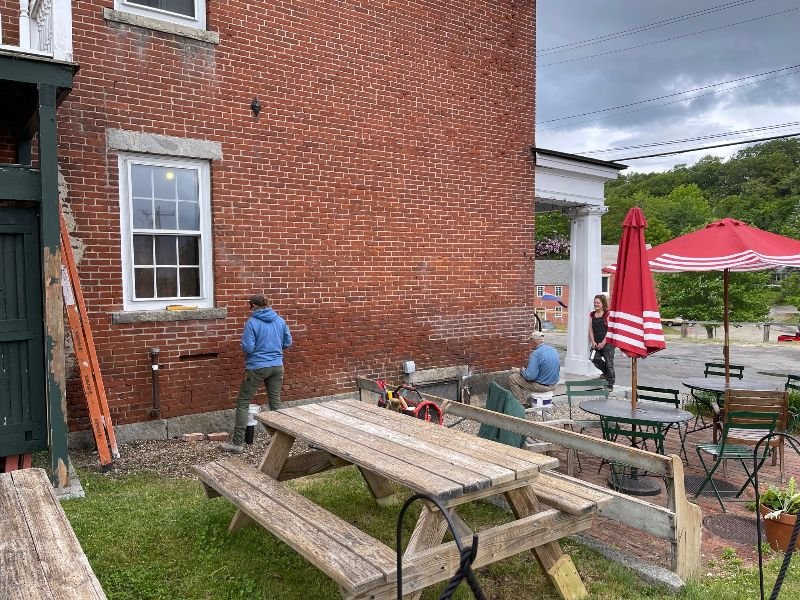Historic Preservation
An in-depth look at HHI’s mission
This is part seven of a seven-part series that explores Historic Harrisville's core programs—preservation, affordable housing, conservation, green energy, the HHI Archives, and the Harrisville General Store.
Last, but certainly not least in our series of Historic Harrisville programs, let’s talk about historic preservation – the heart of Historic Harrisville’s mission-driven work.
Generally speaking, the term "historic preservation" includes four possible “treatments” for historic properties. Rehabilitation and preservation are actively used in Harrisville, while restoration and reconstruction are less common.
Visible Rehabilitation
HHI reviewed proposed work at 9 Island Street, which is under historic preservation covenant. HHI determined that the work, which will occur almost exclusively on the rear of the property, but is visible from the public way, will not harm the historic character or integrity of the property or the historic district.
Rehabilitation is defined as the act or process of making possible a compatible use for a property through repair, alterations, and additions, while preserving those portions or features which convey its historical, cultural, or architectural values. This is the focus of Harrisville’s Historic District Commission (HDC) and HHI’s historic preservation covenants.
To ensure that changes are made in a manner that is appropriate for the property and the historic district, Historic Harrisville holds covenants on 21 properties owned by others. The covenants require HHI’s prior approval for demolition, new construction, changes in use, and any alterations to the exterior of buildings. Changes to two properties – 9 Island Street and 9 School Street – were reviewed and approved by HHI in 2023. HHI is available as a resource to assist the owners of covenant properties in project planning and aims to ensure preservation of these properties because “Harrisville’s land and buildings are of major importance in documenting the architectural and social history of New Hampshire and the nation, and thus should be preserved in the public interest.”
Periodically, HHI conducts proactive monitoring to ensure that no violations to the covenant agreement have occurred, and to document the condition of each building to help the property owners identify and correct problems before they become serious (and thereby excessively costly to fix). Director Erin Hammerstedt conducted the monitoring this summer and was pleased by the care that the property owners are taking in maintaining their homes.
Holding HHI Accountable
With historic preservation covenants and easements in place, all work—both interior and exterior— done at the Granite Mill is reviewed by the Land and Community Heritage Investment Program (LCHIP) and the New Hampshire Division of Historical Resources (DHR) to ensure that it is appropriate for a building of exceptional historic and architectural significance.
There are also preservation covenants and easements on Historic Harrisville’s properties. The Land and Community Heritage Investment Program (LCHIP) holds covenants Granite Mill and the Trip Hammer Shop that regulate changes in use and to the exterior appearance, and the New Hampshire Division of Historical Resources (DHR) holds an easement that applies to the interior and exterior of the Granite Mill. Both covenants are the result of grant funding received for past renovations of those buildings.
As part of our stewardship agreement, HHI submits annual monitoring reports that document the condition of each building and explain any work that has been done. We also inform them of upcoming projects and provide an opportunity for review and approval. The design of the two newest studios in the basement of the Granite Mill, for example, was determined in close consultation with the NH DHR’s easement staff to ensure that the important character defining features of the building were preserved during the renovation and remain visible to the public.
Additionally, like any other property owner in the local historic district, HHI also makes an application to the Harrisville Historic District Commission (HDC) anytime a project will result in a visible exterior change to a building in the village.
Invisible Preservation
If you didn't seen Fred and Kat (shown here) working on the General Store and Post Office this spring, you might not know that major preservation work was completed in 2023. Repointing and repairs are needed on many of HHI's historic buildings.
Preservation is defined as the act or process of applying measures necessary to sustain the existing form, integrity, and materials of an historic property. In essence, preservation is maintaining something without changing it. While this work is common in Harrisville, and is extremely important, it does not require review by the HDC or HHI, and often goes unnoticed.
Some of the most important work we do is essentially invisible. If we are doing our job well, while you might notice that a project is happening because you see Fred, Kat, and/or our contractors at work, ideally, once they’re done, you won’t see any change. Maintaining a building in good condition without making a visible change is the essence of preservation, and something that is ongoing at Historic Harrisville.
Donate to Support Historic Preservation
During this annual fundraising appeal, we aim to raise $30,000 for masonry repairs and painting in 2024. As time and budget allow, we will continue to repaint our brick buildings, repair, and rebuild our stone retaining walls, and paint the mill towers and other wooden elements. Not visible or glamorous capital projects, and therefore difficult to fundraise for at the project level, this work is essential, yet difficult to keep up with while maintaining affordable residential and commercial rents. Your contribution to this annual operating appeal will help ensure we can keep moving forward on our preservation maintenance projects.











Let’s talk about historic preservation – the heart of Historic Harrisville’s mission-driven work. Generally speaking, the term "historic preservation" includes four possible “treatments” for historic properties. Rehabilitation and preservation are actively used in Harrisville, while restoration and reconstruction are less common.